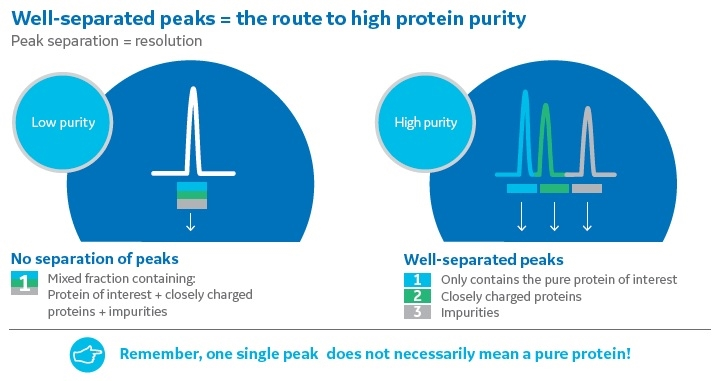The goal of protein purification by chromatography is of course to obtain a pure protein! But in protein research, what you do next with your pure protein—for example, determining the structure of a protein by X-ray crystallography—determines the level of protein purity that you will need.
This article shows why “good enough” protein purity may not be enough when you plan for structural biology study because you will need purity levels > 95%. We also give you a few tips on choosing the right chromatography resin to get the highest protein purity for your chromatography protocol.
Which purity requirements for which application?
If you intend to measure enzymatic activity in a protein functional study the purity of the protein need not be as high as for in structural studies by X-ray crystallography or cryogenic transmission electron microscopy (cryo-EM), where a purity of 95% to 99% is required (Table 1).
In the biopharmaceutical industry, there is no compromise on the purity of therapeutic proteins—the required purity should be > 99% for therapeutic mAbs.
Table 1. Typical levels of protein purity required for different research applications
| Typical applications | Recommended purity level |
|---|---|
| Mass spectrometry
Antigen for immunization |
Moderate to high, 80% to 90% |
| Functional studies e.g., binding assay using surface plasmon resonance
Structural studies e.g., X-ray crystallography |
Very high, 95% to 99% |
| Therapeutic proteins | Highest > 99% |
In structural biology, what is the risk with a protein that is not pure enough?
There are three main techniques used for studying the structure of a protein: X-ray crystallography, cryo-EM, and nuclear magnetic resonance (NMR) spectroscopy. Cryo-EM is gaining popularity in research because it eliminates the need to produce crystals and is also suitable for larger molecules and complexes.
- In X-ray crystallography, poor protein purity makes formation of crystals very difficult, if not impossible. Impurity can be caused by size or charge heterogeneity such as the co-existence of monomeric and multimeric forms of the same protein, or charge variants of a protein. Millions of protein molecules are packed in a repeating array in protein crystals and weak, non-covalent forces hold the molecules together. A 3-D structure derived from a protein crystal is the average structure of the protein molecules. If the protein sample is not pure, only poorly diffracting crystals will be obtained, resulting in a low-resolution protein structure. Poor protein purity may also lead to the failure of protein crystals to form at all, which of course means that vital structural information will not be obtained.
- In cryo-EM, poorly purified protein makes processing of EM images more difficult and the resolution of determined protein structures is lower.
- NMR is less sensitive to impurities as each bond in the molecule contributes to the finally measured data set. Impure proteins make it difficult to determine which peak/signal from the NMR is part of the target protein signal.
To summarize, if the level of purity of the protein of interest is not high enough (95% to 99%), the technique used for the structural study might not be possible to implement requiring time to troubleshoot and understand the cause of the issue. Results could easily be misinterpreted, as the results will only show an average of the properties or miss relevant parts of the structure and only show high-level structural elements (α-helix or β-sheets).
How do I obtain high enough purity for structural biology applications?
These are our 3 top tips for getting the best purity of your protein for structural studies.
- Ensure that you use the right sample preparation steps
Samples for chromatographic purification should be clarified and free from particulate matter. Sample extraction procedures and the selection of buffers, additives, and detergents are determined largely by the source of the material and the stability of the target protein. Sample prep for chromatography is covered in this handbook. - Consider using a multistep purification protocol
If very high purity is needed, a simple one-step protein purification protocol is usually not enough; two, three or in some cases, even four steps in the purification protocol might be needed.
Bear in mind that contaminating small molecules and chemicals can change the structure of your protein without you being able to visualize it on your chromatogram but can still affect the structure of the protein. This problem can be alleviated by increasing the number of steps in the purification protocol.
Generally, adding a size exclusion chromatography (SEC) polishing step at the end of a protocol if the sample contains size variants, or ion exchange chromatography (IEX) when the sample contains charge variants, will help increase the purity level. Here, we explain how to combine chromatography techniques to get the most of every step. - High-resolution columns = high protein purity
There are many different types of chromatography purification columns on the market. Some are designed for high flow rates while others are designed to deliver high resolution and consequently, high protein purity.
To purify protein for structural studies, ensure that you use chromatography columns that deliver the highest resolution possible. If the resolution is insufficient, you might see only a single peak in the chromatogram, which gives you the false impression that the protein is pure. However, the reality is that the peak might correspond to the elution of several proteins/impurities at the same time. If the same sample is applied to a very high-resolution column, multiple peaks will be revealed, and you will be able to collect the peak that corresponds to the protein of interest only (Fig 1).
Fig 1. A single peak does not necessarily mean a pure protein.
What columns support very high resolutions/purity?
Prepacked SEC and IEX columns are a convenient approach to removing unwanted molecules that are very similar to your protein of interest—either proteins that are very similar in size (SEC) or very similar in charge (IEX, see Table 2).
Table 2. Prepacked columns delivering the highest resolution in small-scale preparative protein purification
